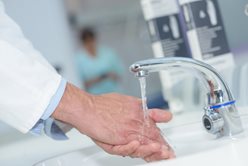(12/5/2022)
 Proper handwashing is one of the most basic and effective elements of infectious disease protocol and protecting vulnerable patients. While it’s easy to assume your associates are taking precautions and washing their hands, handwashing compliance levels often falter over time, according to a University of Chicago Medical Center study.
Proper handwashing is one of the most basic and effective elements of infectious disease protocol and protecting vulnerable patients. While it’s easy to assume your associates are taking precautions and washing their hands, handwashing compliance levels often falter over time, according to a University of Chicago Medical Center study.
Healthcare workers on average are only washing their hands half as many times as they should be per shift, according to the CDC, which recommends washing hands before and after each patient encounter to prevent spreading germs to other patients and staff members, even when gloves are being worn. Frequent and facility-wide use of alcohol-based hand sanitizer, in addition to washing with soap and water, can have a significant impact on preventing healthcare-associated infections.
As we enter flu season which usually peaks in January or February, prepare for a potential upswing in Covid cases, combined with an early surge of RSV this fall, enhancing handwashing compliance is crucial for patient and staff safety. The following tactics can help improve and maintain good hand hygiene to protect the health of all individuals in your facility.
- Use verbal and visual reminders.
While it may seem unnecessary to verbally remind associates to wash their hands, it can be the most effective way of improving compliance. Handwashing compliance peaked in facilities around the country at the beginning of the pandemic when people were regularly discussing its importance. Only a few months later, when hand hygiene became a less common topic of conversation, it returned to pre-pandemic levels for many facilities.
While face-to-face interactions are the most effective way of reminding your team to properly wash their hands, visuals are necessary, as well. Signs around the facility, for instance, are helpful; however, individuals tend to visually tune out these reminders when they see them every day, so they should be used as one element of a larger strategy. Having adequate supplies on hand serves as an additional reminder, while also making hand washing more convenient.
- Leverage tools and technology.
Automated hand-hygiene monitoring systems can act as an additional reminder by prompting individuals to use hand sanitizer (or soap and water) each time they enter and exit a room. These devices also report how often your staff follows the instructions and helps track facility-wide compliance. Mobile apps can also automatically collect data on your facility’s handwashing compliance, which can then be used to adjust your compliance program as needed.
- Make it a team effort.
When your facility has a culture of compliance and clear expectations, hand hygiene will be easier to improve and maintain. A crucial component of this is leaders setting an example of proper hand hygiene. Not only will this showcase the proper behavior, but it will also protect the patients and fellow staff members with whom they interact directly.
As new information continually leads to changes in necessary prevention measures, leaders need to reinforce basic standards in addition to sharing updates. Ongoing education should include reminders of the consequences of inadequate hand hygiene, along with instructions on proper handwashing techniques. Leaders can also share observation data with their team to show how their progress aligns with their goals.
For support with implementing and sustaining an effective handwashing compliance program,
request a consultation or
email us to learn more about our facility management solutions.